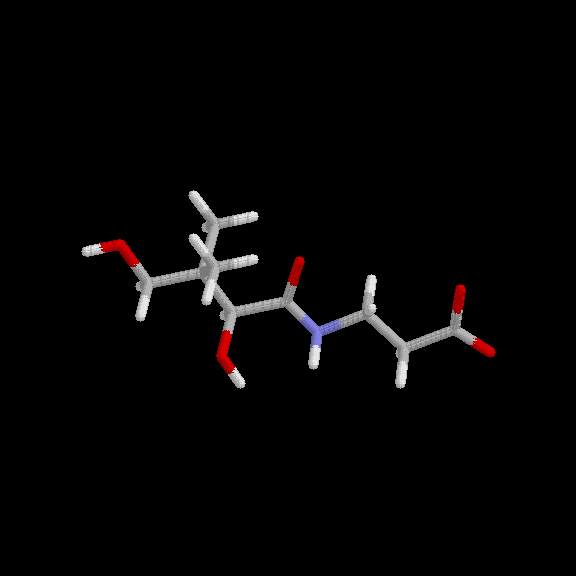R-pantothenate
R-pantothenate, also known as vitamin B5, is an essential nutrient that is required for the production of energy and the metabolism of carbohydrates, fats, and proteins. It is also involved in the synthesis of coenzyme A (CoA), which is a critical cofactor for many metabolic reactions.
R-pantothenate is found in a variety of foods, including meat, poultry, fish, eggs, dairy products, whole grains, legumes, and nuts. It is also produced by some bacteria in the gut microbiome.
R-pantothenate is generally safe for most people, but high doses can cause side effects such as diarrhea, nausea, and vomiting.
Some of the potential health benefits of R-pantothenate include:
- Reduced fatigue: R-pantothenate is essential for the production of energy, and deficiency in R-pantothenate can lead to fatigue.
- Improved athletic performance: R-pantothenate has been shown to improve athletic performance in some studies.
- Reduced cholesterol levels: R-pantothenate may help to reduce cholesterol levels.
- Improved hair and skin health: R-pantothenate is important for the production of collagen, which is a protein that helps to keep hair and skin healthy.
- Reduced risk of neurological disorders: R-pantothenate deficiency has been linked to an increased risk of neurological disorders such as Alzheimer's disease and Parkinson's disease.
R-pantothenate deficiency is rare in healthy people, but it can occur in people who have certain medical conditions, such as malabsorption syndromes or inflammatory bowel disease. R-pantothenate deficiency can also occur in people who do not eat a balanced diet.
If you are concerned about your R-pantothenate intake, you can talk to your doctor about taking a supplement. However, it is important to note that high doses of R-pantothenate can cause side effects.
Pantothenic acid, also known as vitamin B5, is an essential nutrient that all animals need to synthesize coenzyme A (CoA). CoA is essential for metabolizing fatty acids, proteins, carbohydrates, and fats.
Pantothenic acid is found in almost all foods, but the most common form used in dietary supplements and animal feed is calcium pantothenate. This is because calcium pantothenate is more stable than sodium pantothenate or free pantothenic acid, and therefore has a longer shelf life.
Here is a simpler version:
Vitamin B5, or pantothenic acid, is an essential nutrient that all animals need to make energy and break down food. It is found in many foods, but the form used in supplements is calcium pantothenate because it lasts longer.
Accession Number : KLM0000299 This work is released into the public domain; please see our release statement.

Synonyms :
- pantothenate
- pantothenic acid
- pantothenic_acid
Config Rule :
% 'R-pantothenate'
config('R-pantothenate',[
chain([
carboxyl(1),
car(2,hyd&&hyd;),
car(3,hyd&&hyd;),
nit(1,hyd)#,
car(4,oxy?),
car(5,hydroxyl&&hyd;),
car(6,methyl&&methyl;),
hydroxymethyl]),
trans(car(3),car(5),bond(nit(1),car(4)))]).
Smiles String :
[C@2H2]([C](=[O])[O-])[C@2H2]/[NH+]=[C](/[C@2H]([OH])[C@2]([CH3])([CH3])[C@2H2][OH])\[O-]
Terminal :
% 'R-pantothenate'
c(1,12,(0,nonchiral))-[o(3,nil)?,c(2,right)~,o(4,nil)?],
c(2,12,(0,nonchiral))-[c(1,left)~,c(3,right)~,h(1,up)~,h(2,down)~],
c(3,12,(0,nonchiral))-[c(2,left)~,h(3,right)~,h(4,up)~,n(1,(down,isomeric(up)))~],
c(4,12,(0,nonchiral))-[o(5,(nil,isomeric(down)))?,c(5,(down,isomeric(up)))~,n(1,trans)#], c(5,12,(0,chiral))-[o(1,left)~,h(6,right)~,c(4,(up,isomeric(down)))~,c(6,down)~],
c(6,12,(0,nonchiral))-[c(7,left)~,c(9,right)~,c(5,up)~,c(8,down)~],
c(7,12,(0,nonchiral))-[h(8,left)~,c(6,right)~,h(9,up)~,h(10,down)~],
c(8,12,(0,nonchiral))-[h(11,left)~,h(13,right)~,c(6,up)~,h(12,down)~],
c(9,12,(0,nonchiral))-[c(6,left)~,h(14,right)~,o(2,up)~,h(15,down)~],
h(1,1,(0,nonchiral))-[c(2,down)~],
h(2,1,(0,nonchiral))-[c(2,up)~],
h(3,1,(0,nonchiral))-[c(3,left)~],
h(4,1,(0,nonchiral))-[c(3,down)~],
h(5,1,(0,nonchiral))-[n(1,(nil,isomeric(down)))~],
h(6,1,(0,nonchiral))-[c(5,left)~],
h(7,1,(0,nonchiral))-[o(1,nil)~],
h(8,1,(0,nonchiral))-[c(7,right)~],
h(9,1,(0,nonchiral))-[c(7,down)~],
h(10,1,(0,nonchiral))-[c(7,up)~],
h(11,1,(0,nonchiral))-[c(8,right)~],
h(12,1,(0,nonchiral))-[c(8,up)~],
h(13,1,(0,nonchiral))-[c(8,left)~],
h(14,1,(0,nonchiral))-[c(9,left)~],
h(15,1,(0,nonchiral))-[c(9,up)~],
h(16,1,(0,nonchiral))-[o(2,nil)~],
n(1,14,(0,nonchiral))-[h(5,(nil,isomeric(up)))~,c(3,(up,isomeric(down)))~,c(4,trans)#], o(1,16,(0,nonchiral))-[h(7,nil)~,c(5,right)~],
o(2,16,(0,nonchiral))-[h(16,nil)~,c(9,down)~],
o(3,16,(-5.0E-01,nonchiral))-[c(1,nil)?],
o(4,16,(-5.0E-01,nonchiral))-[c(1,nil)?],
o(5,16,(0,nonchiral))-[c(4,(nil,isomeric(up)))?]
The Terminals for all the Config Rules are in Prolog Definite Clause Grammar (DCG) form.They can be checked in the Manual here.
The compound's PDB file can be seen here.
